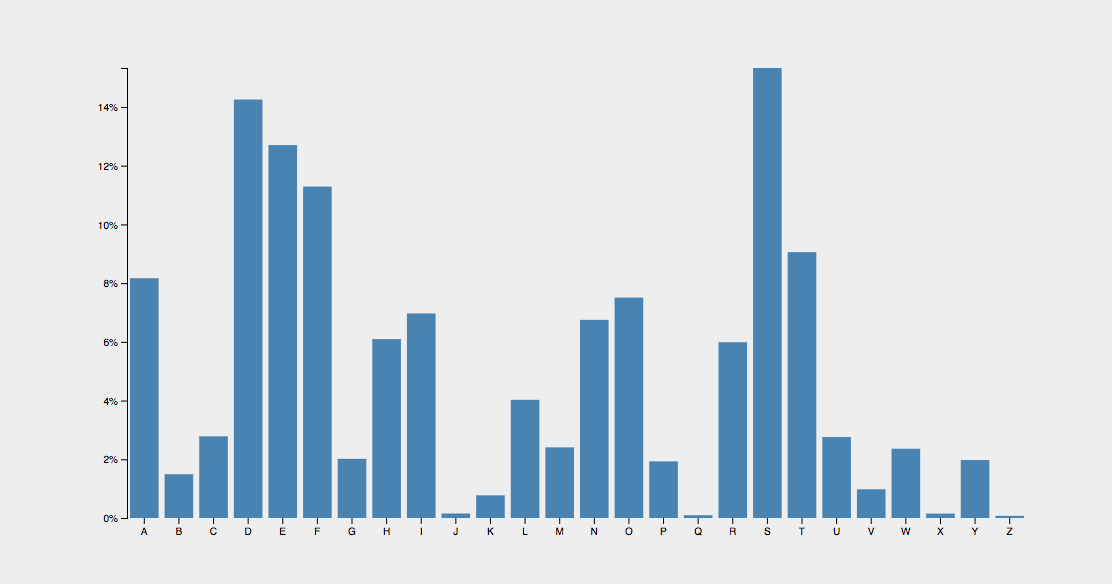Interactive Visualization
The following example shows a basic interactive visualization that reacts to the users keyboard input.
Create a data.csv file with the following content:
letter,frequency A,.08167 B,.01492 C,.02782 D,.04253 E,.12702 F,.02288 G,.02015 H,.06094 I,.06966 J,.00153 K,.00772 L,.04025 M,.02406 N,.06749 O,.07507 P,.01929 Q,.00095 R,.05987 S,.06327 T,.09056 U,.02758 V,.00978 W,.02360 X,.00150 Y,.01974 Z,.00074
Create a index.html file with the following content:
<!DOCTYPE html>
<html>
<head>
<meta charset="utf-8">
<title>Interactive Example</title>
<script src="https://code.jquery.com/jquery-2.1.4.min.js" charset="utf-8"></script>
<script src="https://d3js.org/d3.v4.min.js" charset="utf-8"></script>
<style media="screen">
body, html {
height: 100%;
background: #eee;
}
body {
display: flex;
align-items: center;
justify-content: center;
}
.svg-chart .bar {
fill: steelblue;
}
.svg-chart .bar:hover {
fill: red;
}
.svg-chart .axis {
font: 10px sans-serif;
}
.svg-chart .axis path, .svg-chart .axis line {
fill: none;
stroke: #000;
}
.svg-chart .x.axis path {
display: none;
}
</style>
<script type="text/javascript">
// execute code after the page has been loaded
$(function(){
// we will need some margins as the coordinate space is for the bars
// only and without the axes would be clipped from the SVG
var margin = {
top: 20,
right: 20,
bottom: 30,
left: 40
};
// calculate the innter width and height of the Visualization
var width = 960 - margin.left - margin.right;
var height = 500 - margin.top - margin.bottom;
// create and band scale that maps the characters to positions on
// the band which is our entire width of the visualization
var xScale = d3.scaleBand()
.range([0, width], .1);
// create a linear scale that maps the frequency to our height
var yScale = d3.scaleLinear()
.range([height, 0]);
// create an SVG axis which will render the axis later for us
var xAxis = d3.axisBottom()
.scale(xScale);
// the same for the x axis
var yAxis = d3.axisLeft()
.scale(yScale)
.ticks(10, '%');
// this is the basic configuration of our SVG element
var svg = d3.select('.svg-chart')
.attr('width', width + margin.left + margin.right)
.attr('height', height + margin.top + margin.bottom)
.append('g')
.attr('transform', 'translate(' + margin.left + ',' + margin.top + ')');
// we will create a container for the x axis
var xAxisG = svg.append('g')
.attr('class', 'x axis')
.attr('transform', 'translate(0,' + height + ')');
// same goes for the y axis
var yAxisG = svg.append('g')
.attr('class', 'y axis');
// a function to convert the incoming CSV
function convert(d) {
d.frequency = parseFloat(d.frequency);
return d;
}
// load the CSV file and convert the data
d3.csv('data.csv', convert, function(data) {
// we select all our .bar elements
svg.selectAll('.bar')
// bind it to our incoming data
.data(data)
// calculate the entry set
.enter()
// append a new rect element for each new entry
.append('rect')
.attr('class', 'bar');
// this function will recalculate our visualization
function update() {
// we reserve a spot for each letter on the band
xScale.domain(data.map(function(d) {
return d.letter;
}));
// we look for the highest value
yScale.domain([0, d3.max(data, function(d) {
return d.frequency;
})]);
// create/update the SVG elements representing the axes
xAxisG.call(xAxis);
yAxisG.call(yAxis);
// select all the bars
svg.selectAll('.bar')
// set the position and size using the scales
.attr('x', function(d) {
return xScale(d.letter)+3;
})
.attr('width', xScale.bandwidth()-6)
.attr('y', function(d) {
return yScale(d.frequency);
})
.attr('height', function(d) {
return height - yScale(d.frequency);
});
}
// register a listener for the key press event
$(document).keypress(function(e){
// get the resulting letter
var letter = String.fromCharCode(e.keyCode).toUpperCase();
// look through the data
data.forEach(function(d){
// when found increment frequency
if(d.letter == letter) {
d.frequency += 0.01;
}
});
// recalculate the visualization
update();
});
// initially render the visualization
update();
});
});
</script>
</head>
<body>
<svg class="svg-chart"></svg>
</body>
</html>
